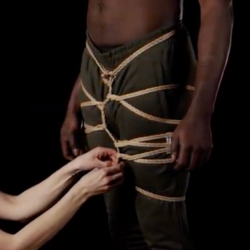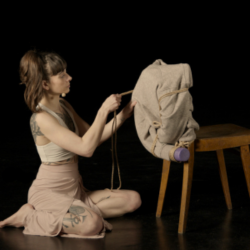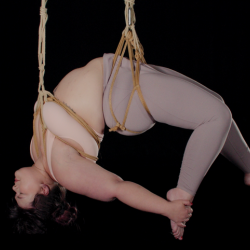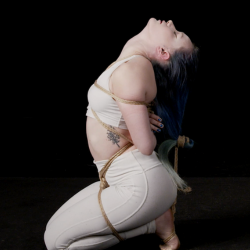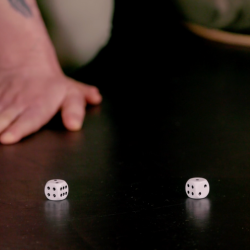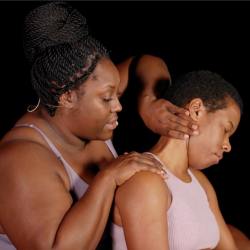This section is subject to partial or total modifications in order to keep our position and suggestions about consent and negotiations up to date and as helpful as possible.
We cannot stress enough the importance of thoroughly educating yourself about consent and negotiations and making sure that your partners are sufficiently informed as well.
We strongly advise that in addition to reading this section carefully you also do your own research about these topics in order to obtain complete, varied and detailed information to form your own educated opinion. We want you to feel safe, rewarded and empowered by your rope experiences! Please feel free to share/use any part or all of the following sections for personal or public use.
GENERAL ADVICE
If you rely only on implied consent, there is room for misinterpretation. You cannot count on someone being able to read your mind anymore than you should assume you can correctly read the mind of others. Do not take the risk of getting put, or putting someone else, into a bad space. Show respect to yourself and your partners and communicate honestly about yourself!
Don't be afraid to have a frank and honest conversation about boundaries and consent with your partner. Remember that consent goes both ways; It is important that everyone involved -regardless of their role- explicitly and honestly states their expectations, limits and experience.
Be sure to discuss all of these things before, especially if tying with someone new, to help prevent consent violations, both intentional and unintentional. It is worth noting that most consent violations are a result of poor communication rather than malicious intent.
Here is a (non-exhaustive) list of suggested questions you may ask each other as part of your pre-rope negotiation :
- What are the safe words for ‘stop’ and for ‘slow down’?
- What is the mood of the scene going to be?
- What is the main purpose of the scene?
- What is the setting of the scene? (context, space, setup,…)
- Is anyone involved under the influence of any judgment/mood/skills altering substance?
- Is there anything, in particular, that is triggering and should be avoided?
- Is there anything, in particular, that is needed/wanted and should be included?
- Is sexual activity welcome in this scene? To what extent? Define ‘sexual’?
- Is nudity or partial nudity welcome in this scene? Does nudity imply sexual activity or not?
- Are other objects than ropes welcome in the scene? (blindfolds, gags, floggers, etc)
- Are there any current injuries or medical conditions that could impact the rope session?
- What kind of aftercare do you prefer?
- Are pictures and videos allowed and if so can they be published?
- When tying in a public space (e.g. workshop, party, rope jam) is anyone else than the rigger allowed to touch or interact with the person being tied? Should the rigger be in charge of enforcing what has been agreed regarding this?
S.S.C. or R.A.C.K. ?
It is important to know your partner's views on BDSM risk and their consent philosophy.
Do they relate more to the S.S.C. (Safe, Sane and Consensual) or R.A.C.K. (Risk Aware Consensual Kink) view? Having a grasp of where your partner stands on regarding risk and consent is important and makes for a more satisfying and rewarding playtime.
Whether you choose S.S.C. or R.A.C.K. be sure to communicate where you stand with your partner as well. Both terms adequately put across the most fundamental idea: that play should be engaged in by consenting parties who are sufficiently knowledgeable, taking all precautions they deem necessary and are both ready to take responsibility for any incident or damage that might occur, whether physical or emotional.
RISK PROFILES
Take the time to establish and update your own personal risk profile and share it clearly and honestly with your partner(s). A risk profile is an evaluation of an individual's willingness and ability to take risks.
It is a way of describing the types, severity, and likelihood of various risks and how they relate to your willingness to participate in certain activities. Risk profiles are a vital element of RACK (Risk Aware Consensual Kink).
There are many risks involved with this practice, both physical and emotional. But something being risky doesn’t automatically make it bad. It all comes down to what activities you are willing to do even when knowing all the risks involved, and how you are able to control and reduce those risks or take responsibility and act in case of an accident.
EXPLICIT CONSENT
What differentiates abuse from BDSM activities is the concept and practice of consent:
- Consent must be given explicitly, freely and enthusiastically
- Consent must be given without any level of coercion (e.g. force, constraint, harassment, intimidation, arguing, insistence, arm-twisting, pressure, threats, persuasion, surprise, etc)
- Consent must be given without any sign of impaired judgment (e.g. hesitation, guilt, pride, confusion, ‘sub-space’ or ‘rope-space’, drugs/medication/alcohol consumption, etc)
- The absence of a ‘no’ is not a ‘yes’ / A ‘maybe’ is not a ‘yes’
- Consent can be revoked: You might change your mind at any time during a session/interaction and ask for something to stop or not to happen even if it had been agreed to beforehand. It must be communicated *very clearly* if you are revoking consent for any activity mid-scene. You do not owe anything to anyone just because you agreed to do it at some point, you are allowed to change your mind just before or during the session. You can ask for a session to end at once if you want/need it to end even after asking/agreeing for the session to take place. If you feel after an interaction that something you agreed to/asked for didn’t feel good, you should re-negotiate clearly before the next session and revoke consent for any activity you do not wish to engage with in the future.
NEGOTIATIONS (before)
It is very important to learn how to properly and usefully negotiate with your partners. There are several tools that you can use to help better negotiate:
- If you are not already familiar with it, we advise you to google the Wheel of Consent by Betty Martin.
- Seek first to understand, then be understood. Ask questions and genuinely listen to the answers from your partner. Seek to understand their genuine motivations and boundaries.
- Make sure to exchange pertinent, clear and concise information about your wishes and boundaries.
- Understand the difference between ‘want to’ and ‘willing to’.
- Start small and simple with your negotiations to ensure they can be properly followed and reinforced.
- Don’t hesitate to use assertive speech when negotiating (e.g. use statements such as “I want” and “I do not want”) and don’t be afraid or ashamed to speak up.
- If you aren't comfortable or not sure if you want to tie with someone, don't tie with them.
- Opportunities: Is there anything either person has wanted to try but not had a reasonable opportunity to experience? Is there anything they feel curious about? Does either have unique talents or skills to offer?
- Is it OK to "experiment" within the borders of stated boundaries and do things that aren't explicitly negotiated for and against or should the scene take place exactly as planned?
- Media Policy: Will photos/videos be permitted? If so, on what devices? Are face shots allowed? Explicit shots? Can these media items be shared, and if so, where and how will the media be appropriately credited?
- Anything Else? Is there anything else to discuss or negotiate about before beginning?
COMMUNICATION (during)
Here are some tips and suggestions to make communication as useful and non-invasive as possible during practice or play:
- When possible, try to give direct, concise, exhaustive and honest feedback: Instead of “Ouch! My ankle!” say “My left ankle hurts, fix it as soon as possible!” or “My left ankle hurts, please don’t touch it!”. This way your partner knows exactly what the problem is and what they can do to best help you deal with it.
- If you are overwhelmed with too much stress or pain and need to be released from a position or even the scene to end immediately, SAY IT. Finishing an exercise during a workshop or snapping one more picture is not worth getting injured or traumatized. You will have plenty of other occasions to give it another try if you wish to!
- Agree in advance if the rigger should check on the bottom or if the bottom is responsible for speaking up in case of any problem or discomfort. If the rigger feels that the bottom’s ability to judge for their own safety has been impaired during the scene, they should reclaim this responsibility and start checking verbally on their partner or end the session.
- Remember to start any new thing you are doing with the low and slow integration method. If you are playing with D/s dynamics you might want to give more slack to your submissive/bottom when trying something new, so they can communicate with you more easily without compromising the dynamic or breaking out of their role/character.
- Always greet a ‘no’ or 'stop' with gratitude and acceptance. Saying ‘no’ can be very hard and any sign of frustration on the receiving end might compromise honest communication in the future. Showing positive reinforcement and acceptance when your partner finds the courage to express their limits and boundaries will encourage them to always communicate freely with you. This is important to protect them from feeling violated but also to protect you from unintentionally violating them. Their ability to say ‘no’ is a gift, not a limitation.
FEEDBACKS AND AFTERCARE (after)
- Make sure to provide what your partner has asked for aftercare (e.g. water, food, a blanket, solitude, closeness, etc.)
- It is important to discuss your experience after a rope scene. Don’t be afraid to share both positive and negative feedback. This way you can get to know each other better and ensure that your rope sessions are as satisfying as possible in the future.
- We strongly advise against renegotiating important boundaries (such as intimate or sexual restrictions or permissions) immediately after a rope scene. Your judgment may still be impaired up to several hours (or days) by the neurochemical reactions due to the scene.
COMMON MISTAKES AND DANGEROUS ASSUMPTIONS
- Consent violation is not restricted to bottoms, tops can have their consent violated as well. Make sure to share your wishes and boundaries as a Top as well.
- We strongly advise against incorporating sexual interactions of any kind in a rope scene with a partner with whom you do not have shared sexual intimacy before.
- Do not assume that what has been negotiated once is still or always valid. People evolve and change, and so do their desires and boundaries. It is important to keep your negotiations updated even with regular partners.
- Do not assume that what has been negotiated with others is valid for you: What you have seen a partner do, accept, or enjoy with someone else does not count as negotiation for your interaction with them - limits, desires, and expectations may vary from a partner to another and fluctuate according to the context, mood, emotional and physical state, etc.
- We strongly advise against mid-scene negotiations or re-negotiations: Judgement may be impaired or even severely impaired from chemical reactions in the body and mind caused by the activities engaged in for both the top and the bottom. Stick to the negotiations agreed upon before the scene, unless you need to revoke consent for any activity. If you have fun with your partner in your scene you can always negotiate another scene to follow up and negotiate the new terms of that scene to be in line with your newly found desires.
- Never guess or ‘take chances’: when in doubt ASK explicitly and wait for a clear and confident YES or NO. The absence of a clear answer = no answer = NO
PERSONAL AND MUTUAL RESPONSIBILITY
- Consent is not passive! It is your responsibility to actively offer transparency and guidance to your partner(s) so they can engage with you in a respectful way. To respect you, they need to know you; only you can provide them with the necessary knowledge of your unique wishes and boundaries.
- Taking responsibility for yourself includes choosing the settings and partners you tie with very carefully. It is of crucial importance to inform yourself about their experience, skills, preferences, reputation, motivations, etc.
- Taking responsibility for yourself also includes the ability to recognize if the environment or person you approached is not a good match for you. It is always ok to come to the conclusion that you should not tie together (today or ever) after discussing and negotiating.
- Remember that any information you choose to withhold before, during or after a scene might compromise yours and your partner's safety.
- Make serious learning efforts concerning methods and techniques related (directly and indirectly) to Shibari in order to enjoy safe and satisfying rope experiences.
- Riggers are responsible for the health and safety of their partners and themselves, and bottoms too are responsible for themselves and communicating with full disclosure to their partners about their needs and limits during a scene.
- Establishing personal and mutual responsibility for a negative experience and/or any unintentional violation can be an extremely challenging process in a state of shock or trauma. You might need to seek support and advice from friends and/or experienced professionals to navigate a recovery and/or accountability process.
NEGATIVE EXPERIENCES AND CONSENT VIOLATIONS
- There is a huge spectrum of consent violations, from personal space invasions to rape and assault. Despite the varying degrees of perceived "severity" throughout the spectrum of consent violation, all consent violations are serious matters.
- In case of negative feelings after a scene, try to make a clear distinction between regretting to have accepted something and feeling you have been coerced, forced or manipulated into accepting something.
- In case of any clear violation of negotiations or consent, we recommend that you seek help and advice with a person or authority you trust, when you feel ready and able to speak about it.
- Unintentional consent violations are STILL consent violations and should be treated as such.
- Did you tell the person that they violated your consent? If not, why not?
- Are you able to tell the person that they violated your consent? Do you need a mediator to help you speak to them?
- Do you feel unsafe to tell the person that they violated your consent? Do you need a third person to speak to them on your behalf?
- Should this person/consent violation be public knowledge? If you believe so, you can speak to local peers, organizers or community leaders you trust.
- What are your expectations for reporting this person/consent violation to your community? Are you hoping they will support an Accountability Process for you and the perpetrator? Are you hoping this person will be banned from spaces/venues you visit? Expressing and managing your expectations and needs might help your friends and community to support you more efficiently and adequately.
- Should this person/consent violation be reported to the legal authorities? If you believe so, you should speak directly to a lawyer.


